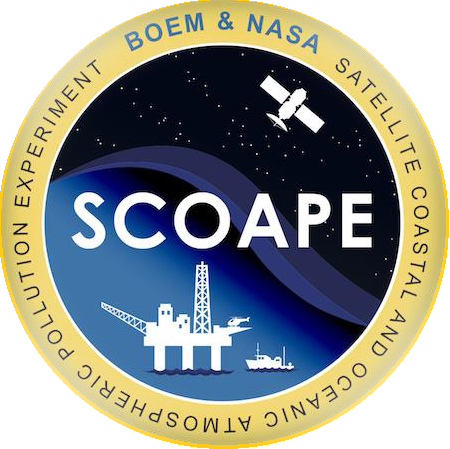Satellite Coastal and Oceanic Atmospheric Pollution Experiment

Disciplines: Field Campaigns
| Collection | Disciplines | Spatial | Temporal |
|---|---|---|---|
|
SCOAPE2_AircraftRemoteSensing_B200_GCAS_Data_1
SCOAPE-II LaRC B-200 Geostationary Coastal and Air Pollution Event (GEO-CAPE) Airborne Simulator Data |
Radiation Budget |
Spatial Coverage: (S: 26.79, N: 36.72), (W: -91.43, E: -77.34) |
Temporal Coverage: 2024-10-07 - 2024-10-16 |
|
SCOAPE2_RVPointSur_Data_1
SCOAPE-II R/V Point Sur Data |
Aerosols, Clouds |
Spatial Coverage: (S: 27.79, N: 29.43), (W: -91.12, E: -87.91) |
Temporal Coverage: 2024-06-02 - 2024-06-15 |
|
SCOAPE2_Sondes_Data_1
SCOAPE-II Sondes Data |
Field Campaigns |
Spatial Coverage: (S: 28.12, N: 29.45), (W: -90.97, E: -87.43) |
Temporal Coverage: 2024-06-03 - 2024-06-13 |
|
SCOAPE_Ground_Data_1
SCOAPE Ground Site Data |
Aerosols, Clouds |
Spatial Coverage: (S: 27, N: 29.5), (W: -92, E: -87.5) |
Temporal Coverage: 2019-04-09 - 2019-05-21 |
|
SCOAPE_Pandora_Data_1
SCOAPE Pandora Column Observations |
Field Campaigns |
Spatial Coverage: (S: 27, N: 29.5), (W: -92, E: -87.5) |
Temporal Coverage: 2019-04-10 - 2019-05-21 |
|
SCOAPE_RVPointSur_Data_1
SCOAPE R/V Point Sur Data |
Aerosols, Clouds, Radiation Budget, Tropospheric Composition |
Spatial Coverage: (S: 26, N: 31.5), (W: -94, E: -84) |
Temporal Coverage: 2019-05-09 - 2019-05-19 |
|
SCOAPE_Sondes_Data_1
SCOAPE Balloon and Ozonesondes Data |
Tropospheric Composition |
Spatial Coverage: (S: 27.5, N: 30), (W: -92, E: -86.5) |
Temporal Coverage: 2019-05-11 - 2019-05-19 |
SCOAPE Mission Publications
Thompson, Anne M.; Kollonige, Debra E.; Stauffer, Ryan M.; Kotsakis, Alexander E.; Abuhassan, Nader; Lamsal, Lok N.; Swap, Robert J.; Blake, Donald R.; Townsend‐Small, Amy; Wecht, Holli D. (2023). Two Air Quality Regimes in Total Column NO2 Over the Gulf of Mexico in May 2019: Shipboard and Satellite Views.
Thompson, Anne M.; Kollonige, Debra E.; Stauffer, Ryan Michael; Kotsakis, Alexander; Abuhassan, Nader; Lamsal, Lok N.; swap, Robert J; Blake, Donald Ray; Townsend-Small, Amy; Wecht, Holli D (2021). Two Air Quality Regimes in Total Column NO2 over the Gulf of Mexico in May 2019: Shipboard and Satellite Views. Earth and Space Science Open Archive, 1. https://doi.org/10.1002/essoar.10511687.1
De Young, Russell; Carrion, William; Ganoe, Rene; Pliutau, Denis; Gronoff, Guillaume; Berkoff, Timothy; Kuang, Shi (2019). Langley mobile ozone lidar: ozone and aerosol atmospheric profiling for air quality research. Applied Optics, 56 (3), 721. https://doi.org/10.1364/AO.56.000721
Dreessen, Joel; Sullivan, John; Delgado, Ruben (2018). Observations and impacts of transported Canadian wildfire smoke on ozone and aerosol air quality in the Maryland region on June 9–12, 2015. Journal of the Air & Waste Management Association, 842. https://doi.org/10.1080/10962247.2016.1161674
Ahmadov, R.; McKeen, S.; Trainer, M.; Banta, R.; Brewer, A.; Brown, S.; Edwards, P. M.; de Gouw, J. A.; Frost, G. J.; Gilman, J.; Helmig, D.; Johnson, B.; Karion, A.; Koss, A.; Langford, A.; Lerner, B.; Olson, J.; Oltmans, S.; Peischl, J.; Pétron, G.; Pichugina, Y.; Roberts, J. M.; Ryerson, T.; Schnell, R.; Senff, C.; Sweeney, C.; Thompson, C.; Veres, P. R.; Warneke, C.; Wild, R.; Williams, E. J.; Yuan, B.; Zamora, R. (2017). Understanding high wintertime ozone pollution events in an oil- and natural gas-producing region of the western US. Atmospheric Chemistry and Physics, 15 (1), 411. https://doi.org/10.5194/acp-15-411-2015
Cooper, Owen R.; Langford, Andrew O.; Parrish, David D.; Fahey, David W. (2017). Challenges of a lowered U.S. ozone standard. Science, 348 (6239), 1096. https://doi.org/10.1126/science.aaa5748
Creamean J M, Neiman P J, Coleman T, Senff C J, Kirgis G, Alvarez R J, and Yamamoto A (2016). Colorado air quality impacted by long-range-transported aerosol: a set of case studies during the 2015 Pacific Northwest fires. Atmospheric Chemistry and Physics, 16 (18), 12329. https://doi.org/10.5194/acp-16-12329-2016
Cooper O R, Ru-Shan G, Tarasick D, Leblanc T, and Sweeney C (2012). Long-term ozone trends at rural ozone monitoring sites across the United States, 1990–2010. Journal of Geophysical Research: Atmospheres, 117 https://doi.org/10.1029/2012JD018261
Cooper O R, Parrish D D, Stohl A, Trainer M, Nédélec P, Thouret V, Cammas J P, Oltmans S J, Johnson B J, Tarasick D, Leblanc T, McDermid I S, Jaffe D, Gao R, Stith J, Ryerson T, Aikin K, Campos T, Weinheimer A, and Avery M A (2010). Increasing springtime ozone mixing ratios in the free troposphere over western North America. Nature, 463 344. https://doi.org/10.1038/nature08708
Cooper O R, Trainer M, Thompson A M, Oltmans S J, Tarasick D W, Witte J C, Stohl A, Eckhardt S, Lelieveld J, Newchurch M J, Johnson B J, Portmann R W, Kalnajs L, Dubey M K, Leblanc T, McDermid I S, Forbes G, Wolfe D, Carey-Smith T, Morris G A, Lefer B, Rappenglück B, Joseph E, Schmidlin F, Meagher J, Fehsend F C, Keating T J, Van Curen R A, and Minschwaner K (2007). Evidence for a recurring eastern North America upper tropospheric ozone maximum during summer. Journal of Geophysical Research: Atmospheres, 112 https://doi.org/10.1029/2007JD008710
Cooper O R, Stohl A, Trainer M, Thompson A M, Witte J C, Oltmans S J, Morris G, Pickering K E, Crawford J H, Chen G, Cohen R C, Bertram T H, Wooldridge P, Perring A, Brune W H, Merrill J, Moody J L, Tarasick D, Nédélec P, Forbes G, Newchurch M J, Schmidlin F J, Johnson B J, Turquety S, Baughcum S L, Ren X, Fehsendfeld F C, Meagher J F, Spichtinger N, Brown C C, McKeen S A, McDermid I S, and Leblanc T (2006). Large upper tropospheric ozone enhancements above midlatitude North America during summer: In situ evidence from the IONS and MOZAIC ozone measurement network. Journal of Geophysical Research: Atmospheres, 111 https://doi.org/10.1029/2006JD007306
